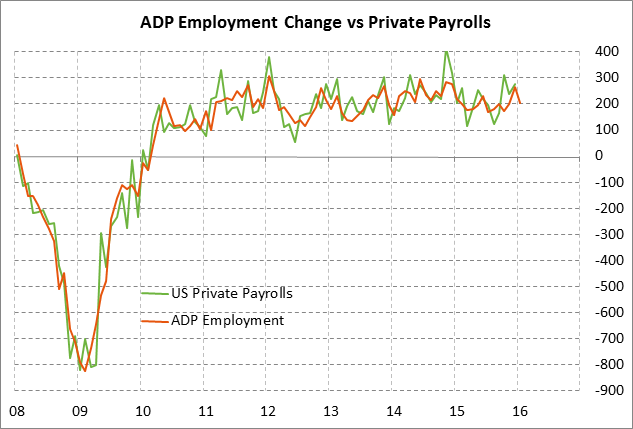- Unemployment claims expected to remain mildly elevated but are not flashing any major warning signs as yet
- Payrolls expected to show trend increase and unemployment rate is expected to remain at a 7-3/4 year low
- Q4 productivity expected to be very poor due in part to weak Q4 GDP gain
- Factory orders expected to show another decline
Unemployment claims expected to remain mildly elevated but are not flashing any major warning signs as yet — The initial and continuing unemployment claims series both remain mildly elevated, thus keeping alive concerns that some businesses might be getting cold feet about the economy. However, the claims data is still within shooting distance of their decade-plus lows, which means the markets should not be overly worried at this point about layoffs. The initial claims series is +23,000 above the 42-year low of 255,000 posted in July 2015 while the continuing claims series is +122,000 above its 15-year low of 2.146 million posted in Oct 2015.
The market consensus is for today’s initial claims series to show a slight -1,000 decline to 277,000, adding to last week’s -16,000 decline to 278,000. The consensus is for continuing claims to fall by -28,000 to 2.240 million, reversing part of last week’s +49,000 gain to 2.268 million. This will be the first report in over a month that the initial claims data will be free of holiday distortions since today’s report will be for the week ended Jan 29.
Payrolls expected to show trend increase and unemployment rate is expected to remain at a 7-3/4 year low — On the labor front, the market is mainly looking ahead to Friday’s Jan payroll report, which is expected to fall back to a longer-term trend increase of +190,000 after the surprising strength seen in Q4 (Oct +307,000, Nov +252,000, Dec +292,000). Yesterday’s Dec ADP report of +205,000 was mildly above expectations of +193,000 and supported the view for a trend increase in Friday’s payroll report.
It will be difficult for Friday’s Jan payroll report to keep up with the 3-month average of an impressive +284,000. Indeed, the downside stock market correction in January and the turmoil caused by China and the 12-year low in oil prices may have caused some businesses to get cold feet about hiring more workers in January and caused them to wait until they have a chance to see how things shake out.
A weaker-than-expected Jan payroll report on Friday would contribute to the sense in the market that the U.S. economy is losing some momentum. A stronger-than-expected Jan payroll report on Friday, by contrast, would support the view that the U.S. economy is still muddling through its various challenges and is in decent shape, all considered.
The market consensus is for Friday’s Jan unemployment report to be unchanged from the 7-3/4 year low of 5.0% posted in the last three reporting months of Oct-Dec. The unemployment rate is only +0.3 points above the Fed’s forecast that the unemployment rate by late this year will fall to 4.7% and remain at that level through 2017-18.
Q4 productivity expected to be very poor due in part to weak Q4 GDP gain — The market is expecting today’s Q4 non-farm productivity report to show a decline of -2.0%, reversing most of the +2.2% increase seen in Q3. Moreover, Q4 unit labor costs are expected to show a sharp increase of +4.1%, up from +1.8% in Q3. The decline in productivity is due to strong staffing levels and a large number of hours worked, combined with the weak level of output as seen in the Q4 GDP report of +0.7%. The expected -2.0% decline in productivity is a bad sign all around since it suggests higher costs for businesses (and lower profits) and downward pressure on real wages.
U.S. productivity improved sharply after the 2007/09 recession as output climbed while staffing levels remained at low recessionary levels. However, productivity has been poor since 2012 because staffing levels have increased (i.e., a larger productivity ratio denominator) even though GDP output has been lackluster (i.e., weak productivity ratio numerator). There is nothing on the horizon to suggest any significant improvement in productivity for at least the next couple of years.
Factory orders expected to show another decline — The market is expecting today’s Dec factory orders report to show a -2.8% decline, adding to the declines seen in November of -0.2% for the headline report and -0.3% for the ex-transportation report. Expectations for a decline in today’s factory orders report are based in part on the already-reported news that durable goods orders in December fell by -1.2% ex-transportation. Orders in the manufacturing sector are in poor shape with Nov factory orders down -4.2% y/y and -6.3% y/y ex-transportation. The weak orders pipeline is a negative leading indicator for manufacturing production and shipments.
The only potential good news on the orders front is that the ISM manufacturing new orders sub-index in January rose by +2.7 points to 51.5, climbing back above the expansion-contraction level of 50 after spending two months (Nov-Dec) in contraction territory. That suggests that manufacturing orders picked up in January despite all the negative news about China, the plunge in oil prices to a 12-year low, and the downside correction in the U.S. stock market.






